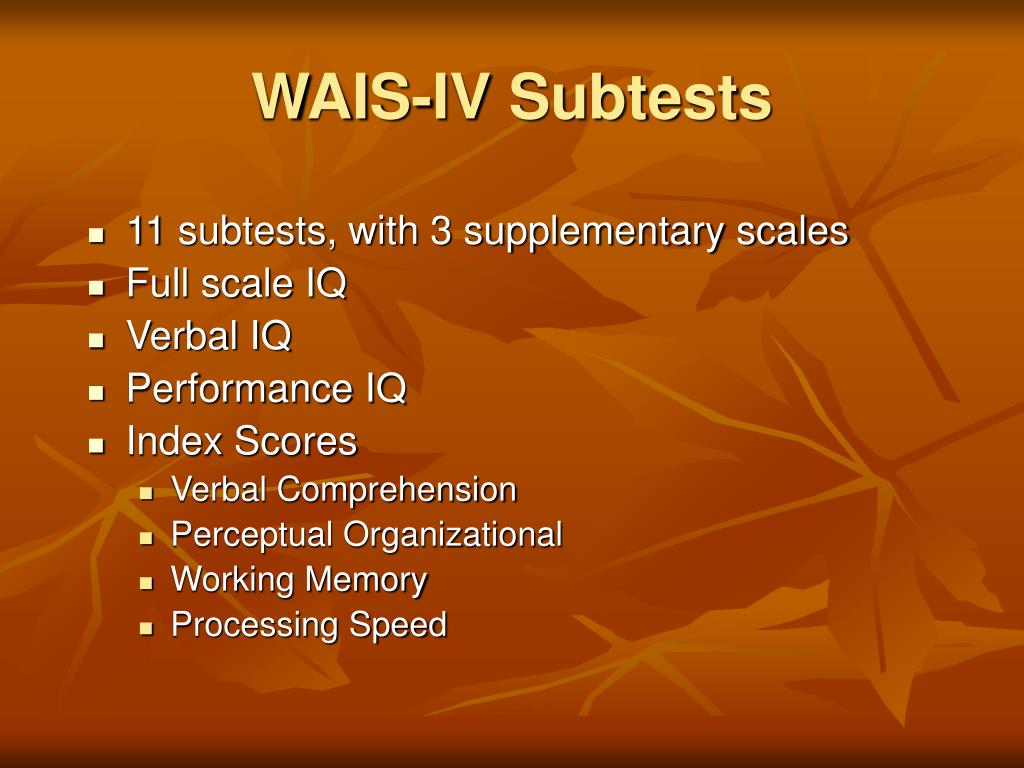

Digit span: attention, concentration, mental control (e.g., Repeat the numbers 1-2-3 in reverse sequence).The Working Memory Index is obtained from three tests Figure Weights : quantitative and analogical reasoning.Picture Completion : Ability to quickly perceive visual details.Matrix Reasoning: Nonverbal abstract problem solving, inductive reasoning, spatial reasoning.Block Design: Spatial perception, visual abstract processing & problem solving.The Perceptual Reasoning Index comprises five tests

Comprehension : Ability to deal with abstract social conventions, rules and expressions (e.g., "What does Kill 2 birds with 1 stone metaphorically mean?").Information : Degree of general information acquired from culture (e.g., "Who is the president of Russia?").Vocabulary: The degree to which one has learned, been able to comprehend and verbally express vocabulary (e.g., "What is a guitar?").Similarities: Abstract verbal reasoning (e.g., "In what way are an apple and a pear alike?").The Verbal Comprehension Index includes four tests: General Ability Index (GAI), based only on the six subtests that comprise the VCI and PRI.
#Weschler adult intelligence scale backward digit span full
Full Scale IQ (FSIQ), based on the total combined performance of the VCI, PRI, WMI, and PSI. Two broad scores are also generated, which can be used to summarize general intellectual abilities: There are four index scores representing major components of intelligence: The GAI is clinically useful because it can be used as a measure of cognitive abilities that are less vulnerable to impairment. The General Ability Index (GAI) was included, which consists of the Similarities, Vocabulary and Information subtests from the Verbal Comprehension Index and the Block Design, Matrix Reasoning and Visual Puzzles subtests from the Perceptual Reasoning Index. With the new WAIS-IV, the verbal/performance subscales from previous versions were removed and replaced by the index scores. The current version of the test, the WAIS-IV, which was released in 2008, is composed of 10 core subtests and five supplemental subtests, with the 10 core subtests comprising the Full Scale IQ. Object Assembly is not included in the PIQ. Two tests Picture Arrangement and Object Assembly were not included in the indexes. The Perceptual organization index included: Included six tests and it also provided two subindexes perceptual organization and processing speed. Letter-Number Sequencing and Comprehension are not included in these indices, but are used as substitutions for spoiled subtests within the WMI and VCI, respectively Performance IQ (PIQ) The Verbal comprehension index included the following tests: Included seven tests and provided two subindexes verbal comprehension and working memory. It provided scores for Verbal IQ, Performance IQ, and Full Scale IQ, along with four secondary indices (Verbal Comprehension, Working Memory, Perceptual Organization, and Processing Speed).įind out your risk today. The WAIS-III, a subsequent revision of the WAIS and the WAIS-R, was released in 1997. This revised edition did not provide new validity data, but used the data from the original WAIS however new norms were provided, carefully stratified. A verbal IQ, performance IQ and full scale IQ were obtained. The Performance subtests were: Picture Arrangement, Picture Completion, Block Design, Object Assembly, and Digit Symbol. The verbal tests were: Information, Comprehension, Arithmetic, Digit Span, Similarities, and Vocabulary. The WAIS-R, a revised form of the WAIS, was released in 1981 and consisted of six verbal and five performance subtests. The WAIS was first released in February 1955 by David Wechsler WAIS-R The WBIS was composed of subtests that could be found in various other intelligence tests of the time, such as Robert Yerkes' army testing program and the Binet- Simon scale. The WAIS was initially created as a revision of the Wechsler- Bellevue Intelligence Scale (WBIS), which was a battery of tests published by Wechsler in 1939.






 0 kommentar(er)
0 kommentar(er)
